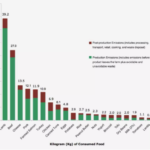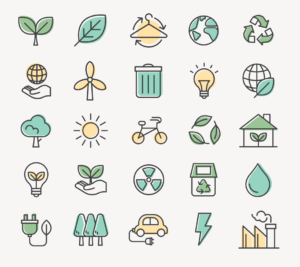So now that we have changed to LED bulbs and lowered our thermostats, what’s next in our arsenal to combat climate change? Would you believe that our food choices matter?
In the US, each household produces 48 tons of greenhouse gases with transportation, housing, and food being the three largest carbon footprints (Food’s Carbon Footprint 2020). Of those categories, food accounts for 10% – 30% of a household’s carbon footprint (Carbon Footprint Factsheet). So, let’s breakdown exactly how food contributes and what we can do to mitigate it.
The food you eat goes through multiple stages before it arrives on your plate. It must be grown and farmed, which may include tilling, cultivating, fertilizing, applying pesticide, watering and harvesting. It then needs to be processed, transported, stored, packaged, distributed, cooked, and, finally, the waste disposed of. Each of these steps may contribute to greenhouse gas emissions–primarily CO2, N2O, and methane – NH4.
So, where does our favorite food fit into all of this? Let’s check out that cheeseburger. Cows and other ruminant animals (like goats and sheep) emit methane, a potent greenhouse gas, as they digest grasses and plants. This process is called “enteric fermentation,” and it’s the origin of cows’ burps. Methane is also emitted from manure, and nitrous oxide, another powerful greenhouse gas, is emitted from ruminant wastes on pastures and chemical fertilizers used on crops produced for cattle feed.
More indirectly, but also importantly, rising beef production requires increasing quantities of land. New pastureland is often created by cutting down trees, which releases carbon dioxide stored in forests. This newly deforested land can be used for pasture, but frequently in the US, feed crops are planted on this land to more efficiently and quickly fatten up the beef. Beef requires 20 times more land and emits 20 times more greenhouse gas emissions (Ranganathan, J. et al. 2016) per gram of edible protein than common plant proteins, such as beans (Waite, R., Searchinger, T., & Ranganathan, J. 2019). Raising beef also requires intensive water use, so degradation of the soil and problems with water pollution from run off can occur. An acre of farmland planted with wheat provides more food for people than if that acre is used to produce food for cattle.
Fig. 1 Full Lifecycle Greenhouse Gas Emissions from Common Proteins and Vegetables
from Climate and Environmental Impacts
So, does that mean I have to give up my burgers? Actually, not unless that’s your choice. If we cut our consumption to about 50 grams per day, equivalent to 1.5 burgers per week, it would eliminate the need for agricultural expansion and deforestation. We also have the tools to more efficiently and sustainably grow beef. However, a vegetarian’s carbon footprint is about two thirds of the average American and almost half that of a meat lover. For a vegan, it is even lower. But perhaps most interestingly, eating chicken instead of beef cuts a quarter of emissions (The carbon foodprint of 5 diets compared).
Remember all those steps it takes to get food to our table? Each one matters. As a consumer, there are some basic principles to keep in mind when choosing a climate friendly eating plan.
- Cut back on meat. If you choose to eat meat, chicken or wild caught fish have a lower CO2 impact than beef or lamb.
- Fruit, vegetables, beans, and nuts have much lower carbon footprints.
- Eat food when it is in season.
- Cut back on dairy and cheese.
- Eat local and organic if possible–farmers’ markets support your local economy and the environment. Think about how far those strawberries traveled when you eat them in January!
- Look for as little packaging as possible and bring your own bags when shopping.
- Eat less processed food and don’t waste it.
Ready to begin a more climate friendly adventure? Here are a few ideas:
- Celebrate Meatless Monday and enjoy Taco Tuesday with black beans rather than beef.
- Try a new food or new recipe each week–get some ideas from different cultures. See resources below for recipes.
- Start a home garden for delicious food, exercise, and satisfaction.
- Check out some meat free meals at local restaurants.
If you move towards a mainly vegetarian diet, you can have a large impact on your personal carbon footprint. Diego Rose, a professor of nutrition at Tulane University and lead author of the study on diet and climate found that in general, diets with a smaller carbon footprint were indeed healthier than those with a large one (Brannon 2019). That’s a double win: better for our health and better for our planet.
Additional Resources:
Calculate your foodprint: https://www.earthday.org/foodprints-calculators/
Compare your food intake with the emissions of driving, heating a home and consuming water: https://www.bbc.com/news/science-environment-46459714
Vegetarian Recipes:
https://www.vegetariantimes.com/
Cited Resources:
Food’s Carbon Footprint. (2020, September 27). Retrieved November 19, 2020, from https://www.greeneatz.com/foods-carbon-footprint.html
Carbon Footprint Factsheet. (n.d.). Retrieved November 19, 2020, from http://css.umich.edu/factsheets/carbon-footprint-factsheet
Ranganathan, J. et al. (2016, April). Shifting Diets for a Sustainable Food Future. Retrieved November 19, 2020, from https://www.wri.org/publication/shifting-diets
Waite, R., Searchinger, T., & Ranganathan, J. (2019, September 13). 6 Pressing Questions About Beef and Climate Change, Answered. Retrieved November 19, 2020, from https://www.wri.org/blog/2019/04/6-pressing-questions-about-beef-and-climate-change-answered
The carbon foodprint of 5 diets compared. (n.d.). Retrieved November 19, 2020, from http://shrinkthatfootprint.com/food-carbon-footprint-diet
Bannon, Keith (2019, January 24). Study: Lower-carbon diets aren’t just good for the planet, they’re also healthier. Retrieved November 19, 2020, from https://news.tulane.edu/pr/study-lower-carbon-diets-aren%E2%80%99t-just-good-planet-they%E2%80%99re-also-healthier
Climate and Environmental Impacts (n.d.) Retrieved November 19,2020, from https://www.ewg.org/meateatersguide/a-meat-eaters-guide-to-climate-change-health-what-you-eat-matters/climate-and-environmental-impacts/




